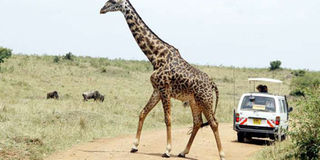Giraffe now faces danger of 'silent' extinction

Tourists having a closer view of a giraffe at the Masai Mara National Reserve. PHOTO | SULEIMAN MBATIAH | NATION MEDIA GROUP
What you need to know:
- In the latest update on threatened species of animals and plants, the International Union for Conservation of Nature (IUCN) says the world’s tallest living mammal could be wiped out if tougher conservation measures are not employed.
- The report released on Thursday includes the Giraffe on the “Red List” and is now labeled as a “Vulnerable” animal, meaning that it faces a higher risk of extinction than previously thought.
- Initially, IUCN which collects and categories data on species based on level of threats they face had listed the giraffe as an animal of “least concern”, meaning that there was no apparent danger to their existence.
The giraffe, once considered an animal that faces little danger in the world, is now facing a “silent” extinction, scientists have warned.
In the latest update on threatened species of animals and plants, the International Union for Conservation of Nature (IUCN) says the world’s tallest living mammal could be wiped out if tougher conservation measures are not employed.
The report released on Thursday includes the Giraffe on the “Red List” and is now labeled as a “Vulnerable” animal, meaning that it faces a higher risk of extinction than previously thought.
Initially, IUCN which collects and categories data on species based on level of threats they face had listed the giraffe as an animal of “least concern”, meaning that there was no apparent danger to their existence.
The new revelations now mean that the giraffe has lost more than a third of its population since 1980, and can now be considered among a group of animals and plants that require serious conservation attention.
Scientists say the danger comes from humans who are hunting these animals illegally, clearing their habitats for agriculture, mining and settlement as well as growing human-wildlife conflict.
The new categorisation means that the giraffe is at the lower end of the threatened group of animals. IUCN normally classifies threatened animals as vulnerable, endangered or critically endangered; with the latter being closest to extinction.
Inger Andersen, the Director-General of IUCN said the new listing should awaken governments to invest more in protecting these animals.
“Many species are slipping away before we can even describe them. This IUCN Red List update shows that the scale of the global extinction crisis may be even greater than we thought,” she said in a statement.
The giraffe, known by its scientific name as Giraffa Camelopardalis lives mostly in eastern, central southern Africa with smaller groups found West Africa. It lives by browsing leaves and lives as one species categorised in eight sub-species.
In August, scientists from Germany and Canada published a study in which they claimed to have identified three new species of the giraffe, arguing the findings could help tailor conservation efforts for each species.
But IUCN has yet to endorse the findings. The organisation estimates that their numbers have fallen from more than 150,000 in 1985 to about 97,000.
Part of the problem, argued Dr Julian Fennessy, the Director of the Giraffe Conservation Foundation which has offices in Nairobi, is that there has been little to no attention given to the habitat occupied by the giraffe.
“Whilst giraffe are commonly seen on safari, in the media and in zoos, people – including conservationists – are unaware that these majestic animals are undergoing a silent extinction,” he said.
“The world’s tallest animal is under severe pressure in some of its core ranges across East, Central and West Africa. As one of the world's most iconic animals, it is timely that we stick our necks out for giraffe before it is too late,” he added.
The new report was published on the sidelines the 13th Conference of the Parties to the Convention on Biological Diversity (CBD COP13) in Cancun, Mexico. The IUCN Red List now includes 85,604 species of which 24,307 are threatened with extinction.
Also threatened are African grey parrot which could be wiped out from the wild by unregulated trapping and the fish species native to Lake Victoria, a problem the report says is caused by the introduction of the “invasive” Nile Perch as well as uncontrolled fishing.
The IUCN Red List update also includes data on wild oats, barley, mango and other crop wild relative plants, arguing their potential extinction could affect technology and research on disease and drought resistant crops.





